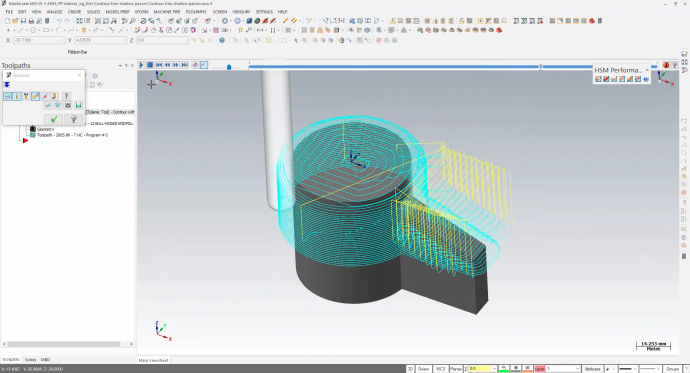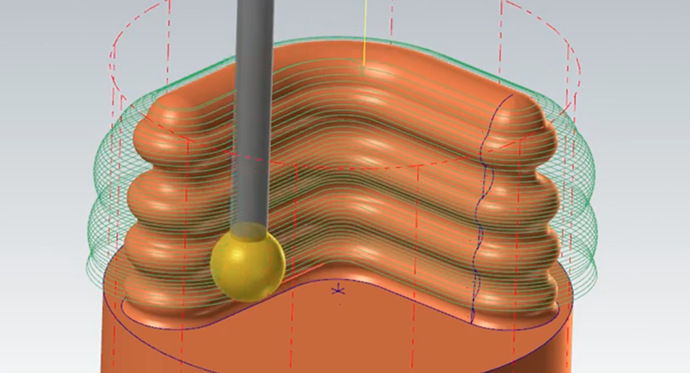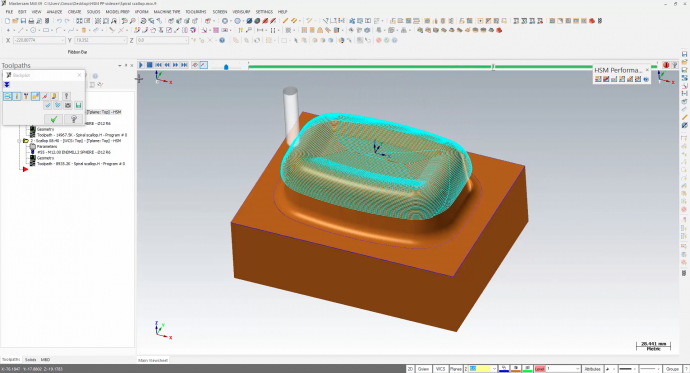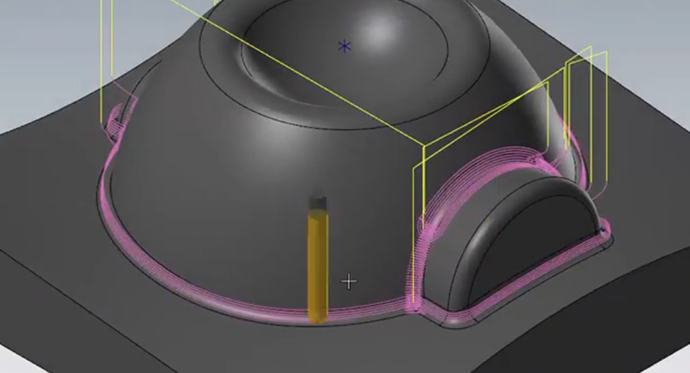Roughing strategies
Constant Cut
Constant Cut is a roughing strategy which allows for much faster machining times than traditional roughing without tool breakage. Constant Cut can be used for all your 3D roughing requirements and can machine both open and closed pockets as well as cores by machining from outside or from inside.
Pocket is the main roughing strategy for clearing large quantities of material effectively. The part is cleared layer by layer with smooth offset contours maintaining climb milling throughout the operation. To avoid plunging, the tool ramps down along a helical path between levels. To maintain a high feed rate, and thereby reducing the machining time, sharp changes of direction are avoided by smoothing the tool motion.
Finishing strategies
Contour
The Contour strategy is designed to give you an optimal finish for steep regions in your geometry. It is typically applied to areas where the slope exceeds an angle of 30 degrees. The Contour algorithm virtually slices the geometry into horizontal layers. At every layer the toolpath then machines along the edge of the two-dimensional geometry thus created. You can control the vertical distance between the toolpath layers with the stepdown parameter.
The Contour strategy contains a new cutting method called Spiral. Using the spiral, the toolpath moves downwards on the part in a steady spiral, without any transitions. Through this transitionless contour, the strategy leaves no transition marks on the part, creating a much nicer finish than a conventional contour operation. In addition, the machine dynamics are maintained at all times, since the depth changes are much more gradual.
Horizontal
The horizontal clearing strategy automatically detects all the flat areas of the part and clears them with an offsetting path. When the flat area is shelved above the surrounding areas, the cutter moves beyond the outline to clean the edges. Horizontal supports processing open flat areas from the outside. It allows to avoid unnecessary ramping and shorten machining time.
Parallel
Parallel is a versatile finishing strategy which is usually applied for shallow or relatively flat regions in your geometry. As the name implies, the Parallel strategy rasters along the surface in parallel lines, either back and forth (zig-zag) or in one direction only. This means that when looking at the part from straight above, the toolpath will look like a set of parallel lines in a plane but the tool of course always follows the height of the geometry.
Scallop
Scallop finishing creates passes that are at a constant distance from one another by offsetting inwards along the surface. The passes will follow sloping and vertical walls to maintain the stepover. Although scallop finishing can be used to finish an entire part, it is most commonly used for rest finishing, following a combination of contour and parallel passes. The rest area is defined by specifying the dimensions of the previous tool.
Like the other finishing strategies, machining can be limited by a contact angle range.
Pencil
The pencil strategy creates tool paths along internal corners and fillets with small radii removing material that no other strategy can reach. It is even possible to make pencil paths along fillets that are larger than the tool corner radius by setting the overthickness parameter.
Pencil paths can form the basis of many other machining operations. You can either make a limited number of offsets from a pencil path to clear a fillet or make an unlimited number of offset paths in order to finish the entire surface from the corners outwards.
Radial
The Radial strategy is a finishing strategy well-suited for high-quality surfaces in shallow curved geometries. The toolpath follows projected radial lines with a defined center point. For spherical shapes, the center point is usually chosen to be the top of the sphere or sphere segment. It is reasonable to restrict the Radial operation to shallow regions and subsequently machine steep regions with more suitable finishing strategies such as Contour.
You can control exactly in which region of your geometry the Radial strategy should be applied, by selecting the inner and outer radius of the operation as well as a range of angles. Additionally you can select whether the cuts should be carried out in zig-zag, only inwards or only outwards. You can freely configure the lead-in and lead-out moves of the operation. HSM Performance Pack generates lead arcs with optimal smoothness to minimize the tool wear.
Spiral
The Spiral strategy is a finishing strategy well suited for high-quality surfaces in shallow curved geometries. The toolpath follows a projected spiral with a defined center point and spacing between the spiral passes.
You can control exactly in which region of your geometry the Spiral strategy should be applied, by selecting the inner and outer radius of the operation. Additionally you can select whether the spiral should be oriented clockwise or counter-clockwise. You can freely configure the lead-in and lead-out moves of the operation. HSM Performance Pack generates lead arcs with optimal smoothness to minimize the tool wear.
5-axis strategies
Below is an outline of the 5-axis machining strategies included in HSM Performance Pack.
Swarf
The Swarf finishing strategy provides a quality that is near perfect. Unlike other strategies, the Swarf strategy utilizes the side of the tool for machining and leaves a surface finish without any stepover or stepdown marks. Due to the nature of Swarf, there are some limitations to where the strategy can be applied.























